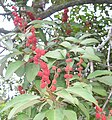Note: This is a project under development. The articles on this wiki are just being initiated and broadly incomplete. You can Help creating new pages.
Mallotus philippensis - Kamala tree
Mallotus philippensis or Kampillaka or Kumkumada mara is a tree that bears fruits which give out red coloured powder which is used as a dye. The dye is known for its anthelmintic properties[1].
Contents
- 1 Uses
- 2 Parts Used
- 3 Chemical Composition
- 4 Common names
- 5 Properties
- 6 Habit
- 7 Identification
- 8 List of Ayurvedic medicine in which the herb is used
- 9 Where to get the saplings
- 10 Mode of Propagation
- 11 How to plant/cultivate
- 12 Commonly seen growing in areas
- 13 Photo Gallery
- 14 References
- 15 External Links
Uses
Anthelmintic, Skin infections, Stomach ulcer, Tapeworm infections.[2]
Parts Used
Chemical Composition
It contains Rottlerin, Mallotoxin[4]
Common names
| Language | Common name |
|---|---|
| Kannada | Kunkumada mara |
| Hindi | Kamala, Rohini |
| Malayalam | NA |
| Tamil | Kapila, Kumkumam |
| Telugu | Kumkuma, Sindhuri |
| Marathi | NA |
| Gujarathi | NA |
| Punjabi | NA |
| Kashmiri | NA |
| Sanskrit | Kampilla, Ranjana, Rechanaka |
| English | Kamala tree, Monkey Face Tree |
Properties
Reference: Dravya - Substance, Rasa - Taste, Guna - Qualities, Veerya - Potency, Vipaka - Post-digesion effect, Karma - Pharmacological activity, Prabhava - Therepeutics.
Dravya
Rasa
Guna
Veerya
Vipaka
Karma
Prabhava
Habit
Identification
Leaf
| Kind | Shape | Feature |
|---|---|---|
| Leaves are opposite on the stem | Ovate to oblong in shape | The upper surface is green without hairs, the underside pale grey in colour. |
Flower
| Type | Size | Color and composition | Stamen | More information |
|---|---|---|---|---|
| Yellow-brown flowers form on racemes | Racemes up to 6 cm long | New South Wales flowering period is from June to November | Flowering period in the Philippines is March to April |
Fruit
| Type | Size | Mass | Appearance | Seeds | More information |
|---|---|---|---|---|---|
| 6 to 9 mm broad | covered in red powdery substance | seeds 2 to 3 mm in diameter | Fresh seed is advised for germination. | Fruiting season is from January to April |
Other features
List of Ayurvedic medicine in which the herb is used
Where to get the saplings
Mode of Propagation
How to plant/cultivate
A plant of lower elevations in the tropics, where it can be found from sea level to 1,600 metres. It grows best in areas where annual daytime temperatures are within the range 25 - 34°c, but can tolerate 7 - 45°c. [6]
Commonly seen growing in areas
South Asia, Southeast Asia, Afghanistan and Australia, Mount Keira, South of Sydney.
Photo Gallery
Red kamala at its most southerly point of natural distribution, Mount Keira, Illawarra, Australia
Black-crested bulbul feeding on the red kamala at Jayanti, India
References
- ↑ Template:Cite journal
- ↑ Indian Medicinal Plants by C.P.Khare
- ↑ 3.0 3.1 ”Karnataka Medicinal Plants Volume-3” by Dr.M. R. Gurudeva, Page No.315, Published by Divyachandra Prakashana, #6/7, Kaalika Soudha, Balepete cross, Bengaluru
- ↑ [Chemistry]
- ↑ Kappatagudda - A Repertoire of Medicianal Plants of Gadag by Yashpal Kshirasagar and Sonal Vrishni, Page No. 266
- ↑ Cultivation
External Links
- Ayurvedic Herbs known to be helpful to treat Anthelmintic
- Ayurvedic Herbs known to be helpful to treat Skin infections
- Ayurvedic Herbs known to be helpful to treat Stomach ulcer
- Ayurvedic Herbs known to be helpful to treat Tapeworm infections
- Herbs with Fruits used in medicine
- Herbs with Stem used in medicine
- Herbs with Leaves used in medicine
- Herbs with Root used in medicine
- Herbs with common name in Kannada
- Herbs with common name in Hindi
- Herbs with common name in Tamil
- Herbs with common name in Telugu
- Herbs with common name in Sanskrit
- Herbs with common name in English
- Habit - Seeds
- Habit - Cuttings
- Index of Plants which can be propagated by Seeds
- Herbs that are commonly seen in the region of South Asia
- Herbs that are commonly seen in the region of Southeast Asia
- Herbs that are commonly seen in the region of Afghanistan and Australia
- Herbs that are commonly seen in the region of Mount Keira
- Herbs that are commonly seen in the region of South of Sydney
- Herbs




